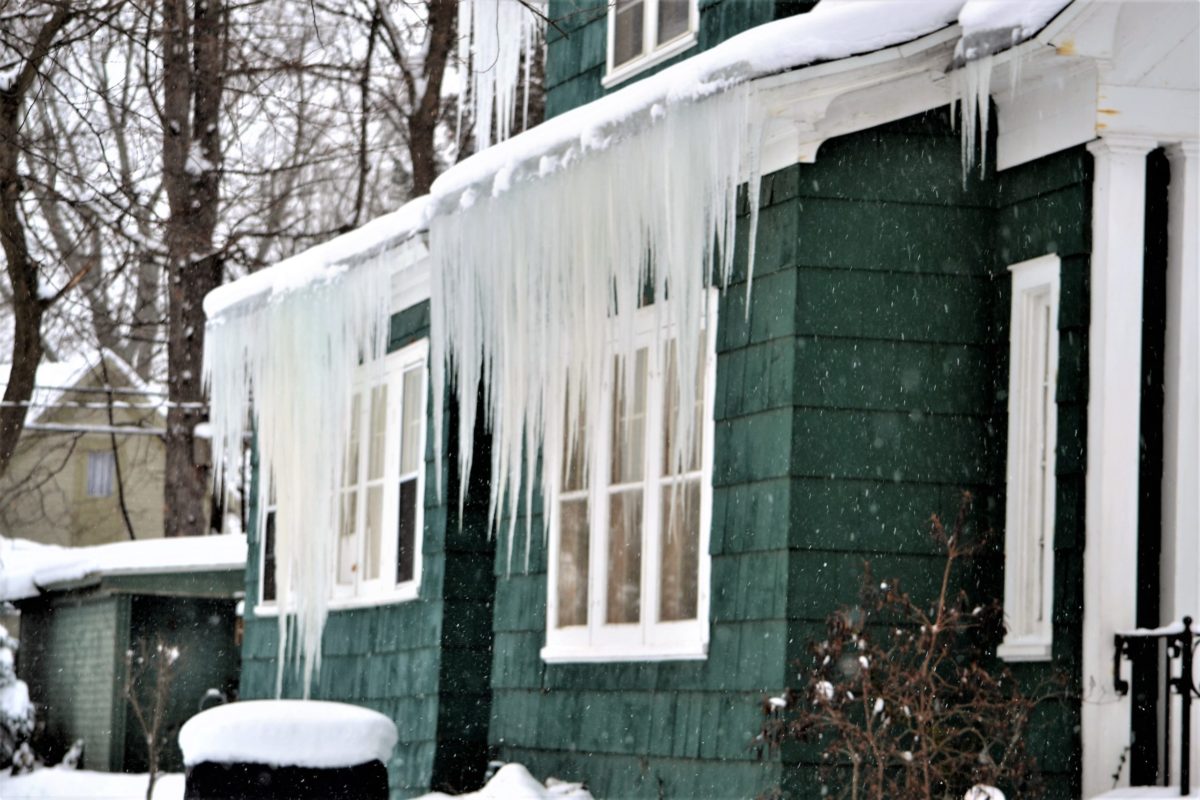5 Ice Dam Removal Attempts to Avoid

Posted on February 8, 2022 by Phillip Camerer
Homeowners know that any kind of roof repair is more expensive in the winter season due to the dangerous conditions. Some might even be tempted to handle a roofing problem on their own which could lead to even more problems, especially when it concerns ice dams or snow removal.
What is an Ice Dam on a Roof?
It is simply a ridge of ice along the eaves that obstructs the flow of water from melting snow on the roof. When the melted snow doesn’t escape the roof and the temperatures drop, the water refreezes which can lift shingles out of place and cause other damages to the roof. Ice dams will eventually lead to leaks that can rot and destroy the structure of your home. Not only do you have to worry about warm weather melting the snow above a forming ice dam, making it even bigger, but you should also be concerned about the warm air inside your attic. The warmth through the roof can also contribute to melting the snow but when the water touches the eaves along the edge of the roof, which is much colder than the roof itself, the water simply refreezes again creating a barrier.
Dangers of Ice Dams
Ice dams work their way underneath shingles by pushing them up as they freeze, expand – which allows more water in a bigger area, thaws, and refreezes. This process is repeated until it is removed or warmer temperatures melts it away, leaving your home vulnerable to the next round of winter weather. Not only can ice dams cause internal structural damage but it can also damage the gutters, cause rotting along the edges of the roof, as well as siding damage if not properly removed in time. As an ice dam forms and its weight increases, further blocking more and more melted water from draining off the roof, the ice dam puts even more strain on the affected shingles, gutters, and even the roof’s structure.
How to Avoid Roof Damage from Ice Dam Removal
- Never use a hair dryer, heat gun, pressure washer, or any electrical device to remove snow and ice. The ice simply will not melt fast enough to drain off the roof and the added pressure of the force coming out of the pressure washer can end up ripping shingles off.
- Never use any open-flames to remove either snow or ice. Any ice that does melt can end up leaking into your home instead of running off the roof. In addition, you could end up damaging the shingles as well as putting yourself at risk from injury.
- Never chop, chip, or hack at the ice to break it into chunks, as it can cause damage to the roof and the protective layer of shingles or treated metal. As the ice dam formed, the water froze to and underneath the shingle so trying to chip away at it will either tear off the protective layer or possibly the whole shingle. Professionals can break ice dams as they also use steaming methods to help melt it at the same time. If it is a substantial size ice dam, breaking it can be dangerous if not done properly as property damage and personal injury could occur.
- Never use a roof rake as a pick to try and hack at the ice. While roof raking can help minimize the chance of ice dams, it won’t remove them. Instead you will end up damaging shingles or scraping the treated metal. Before roof raking any snow off your roof, check with your roofing professional to make sure it is necessary as improper snow roof raking can also end up damaging your shingle or metal roof. If it is recommended, be sure to remove the snow immediately after it falls while it is still soft. Remember it is unnecessary to climb a ladder for snow roof raking as they have extended handles and to leave the last 2-3 inches of snow to ensure you don’t scrape against the roofing materials. Keep in mind that any snow that is raked off will fall on any vegetation near the foundation as well.
- It isn’t recommended to use salt or chemicals in an effort to melt the ice. Calcium chloride only works during optimal temperatures and if any leaks are forming, the saltwater mixture has now leaked into and all over the house. If you are completely positive that there are no cracks or leaks and still want to use salt, be sure to never substitute with rock salt and only use calcium chloride.
Call the Professionals
When the ice dam is removed and the damage is assessed, remember to prepare for the next season to help prevent the issue from occurring again. Take proactive steps to protect your roof and home from future ice dams and further damage. While some homeowners may be tempted to try to fix their problem on their own, it is best to get assistance from the professionals for the protection of your home and yourself! If you discover any leaks or are concerned about damage from ice dams, reach out to us at Phillip Camerer Roofing.
